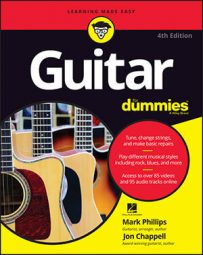Intonation refers to the accuracy of the pitches produced by fretting. For example, if you play the 12th fret, the resulting note should be exactly an octave higher than the open string. If the 12th-fret note is slightly higher than an octave, your string is fretting sharp; if the 12th-fret note is slightly lower than an octave, the string is fretting flat.
You can correct a string's intonation by moving the saddle away from the nut if the string frets sharp and toward the nut if the string frets flat. Different bridges have different methods for this, but it's pretty obvious when you look at the bridge assembly carefully.
In one common mechanism (used on Fender Stratocasters and Telecasters), screws at the back of the bridge determine the saddle front-to-back position. Here's how they work:
Turning the screw clockwise (with a simple Phillips or flat-head screwdriver — being careful not to ding the top with the handle as you turn the screw) pulls the saddle back toward the bridge, which corrects a string that frets sharp.
Turning the screw counterclockwise moves the saddle toward the nut, which corrects a string that frets flat.
Keep in mind that adjusting the saddle for a string corrects only that string. You must perform intonation adjustments for each string. So don't invite us to that 38-string guitar's intonation adjustment!
Put on brand-new strings before you adjust the intonation. Old strings often fret sharp and don't give you a true reading of your intonation.

